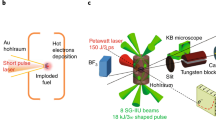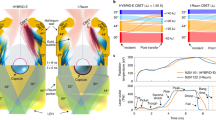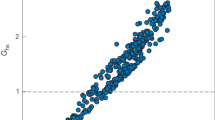Abstract
A conceivable approach to the problem of achieving controlled thermonuclear power is by impact fusion1–3. Small projectiles (macrons4), of mass ∼0.1 g and of appropriate material and design, are accelerated to a velocity v∼108cms−1; they then collide with a deuterium–tritium target, and their kinetic energy is abruptly converted into thermal energy (∼10keV per nucleon, temperature ∼108 K) that is inertially confined in a shocked region. Preliminary studies1,2 in the early 1960s showed that in these conditions the released nuclear energy exceeds the initial kinetic energy. Despite its attractiveness, relatively little research has been devoted to the development of impact fusion as a power-producing technology, and only recently5 have serious attempts been made to evaluate its importance compared with the more familiar proposed methods of magnetic and inertial confinement. The principal block to impact fusion is the development of accelerators capable of accelerating macrons to velocities two orders of magnitude greater than can be attained by existing methods. It is shown here, using general arguments, that the minimum length of such macron accelerators must exceed 1 km. A possible way of achieving the required high velocity is to accelerate, in a travelling electric field, macrons that are self-charged by electron field emission.
This is a preview of subscription content, access via your institution
Access options
Subscribe to this journal
Receive 51 print issues and online access
$199.00 per year
only $3.90 per issue
Buy this article
- Purchase on Springer Link
- Instant access to full article PDF
Prices may be subject to local taxes which are calculated during checkout
Similar content being viewed by others
References
Harrison, E. R. Phys. Rev. Lett. 11, 1 (1963).
Winterberg, F. Z. Naturforsch. 19 a, 231 (1964).
Maisonnier, C. Nuovo Cim. 423, 332 (1966).
Harrison, E. R. Plasma Phys. 9, 183 (1967).
Peaslee, A. T. (ed.) Proc. Impact Fusion Workshop, LA-8000-C (Los Alamos Scientific Laboratory, 1979).
Marshall, R. A. in Proc. Impact Fusion Workshop, LA-8000-C (Los Alamos Scientific Laboratory, 1979).
Ribe, F. L. & Vlases, G. C. in Proc. Impact Fusion Workshop, LA-8000-C (Los Alamos Scientific Laboratory, 1979).
Kreisler, M. N. in Proc. Impact Fusion Workshop, LA-8000-C (Los Alamos Scientific Laboratory, 1979).
Good, R. H. & Müller, E. W. Handb. Phys. 21, 187 (1956).
Author information
Authors and Affiliations
Rights and permissions
About this article
Cite this article
Harrison, E. Impact fusion and the field emission projectile. Nature 291, 472–473 (1981). https://doi.org/10.1038/291472a0
Received:
Accepted:
Issue Date:
DOI: https://doi.org/10.1038/291472a0
Comments
By submitting a comment you agree to abide by our Terms and Community Guidelines. If you find something abusive or that does not comply with our terms or guidelines please flag it as inappropriate.



